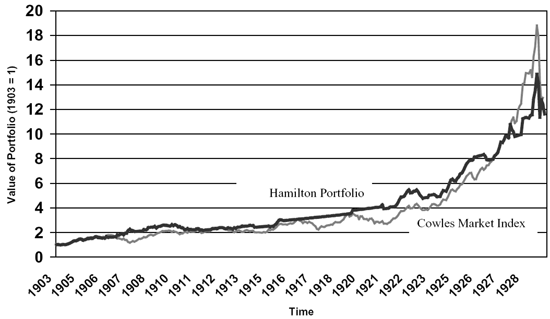We have selected for retrospective review a few all-time “best selling” research papers of the past few years from the General Financial Markets category of the Social Science Research Network (SSRN). Here we summarize the March 1998 paper entitled “The Dow Theory: William Peter Hamilton’s Track Record Re-Considered” (download count nearly 5,900) by Stephen Brown, William Goetzmann and Alok Kumar. This research applies risk adjustment and out-of-sample testing to re-examine Alfred Cowles’ 1934 debunking of the Dow Theory (as defined by the 255 editorials of William Peter Hamilton in The Wall Street Journal during 1902-1929). They conclude that:
- Hamilton was right about the short-term direction of the stock market about 60% of the time. His accuracy rate was higher during bear markets than during bull markets.
- Hamilton’s (Dow Theory) timing approach produces high Sharpe ratios and positive alphas during 1902-1929. This result counters Cowles’ 1934 analysis, which did not include risk adjustment. Adjustment for risk appears to vindicate Dow Theory. (See chart below.)
- Since 1929, the Dow Theory appears to have some predictive power, but trading frictions preclude large excess returns, especially since the 1970s. The theory has continued to offer reduced portfolio volatility. The faster the execution of the theory’s trading signals, the better its returns.
- Dow Theory, as articulated by Hamilton, is a trend (momentum) strategy.
The following chart, extracted from the paper, compares the performance of a Dow Theory-driven (Hamilton) portfolio with that of the broad market (Cowles Market Index) during 1902-1929. The chart shows that Dow Theory dampened volatility and even provided higher raw returns over significant periods, especially periods with downturns.

The paper also provides a concise description and early history of the Dow Theory, including Cowles’ 1934 analysis. One of the theory’s fundamental axioms, in Hamilton’s own words, is: “Prosperity will drive men to excess, and repentance for the consequences of those excesses will produce a corresponding depression.” There is a never-ending cycle of irrational optimism and irrational pessimism.
In summary, the Dow Theory has generated excess risk-adjusted (but not raw) returns when compared to buy-and-hold over some significant periods by following large trends.